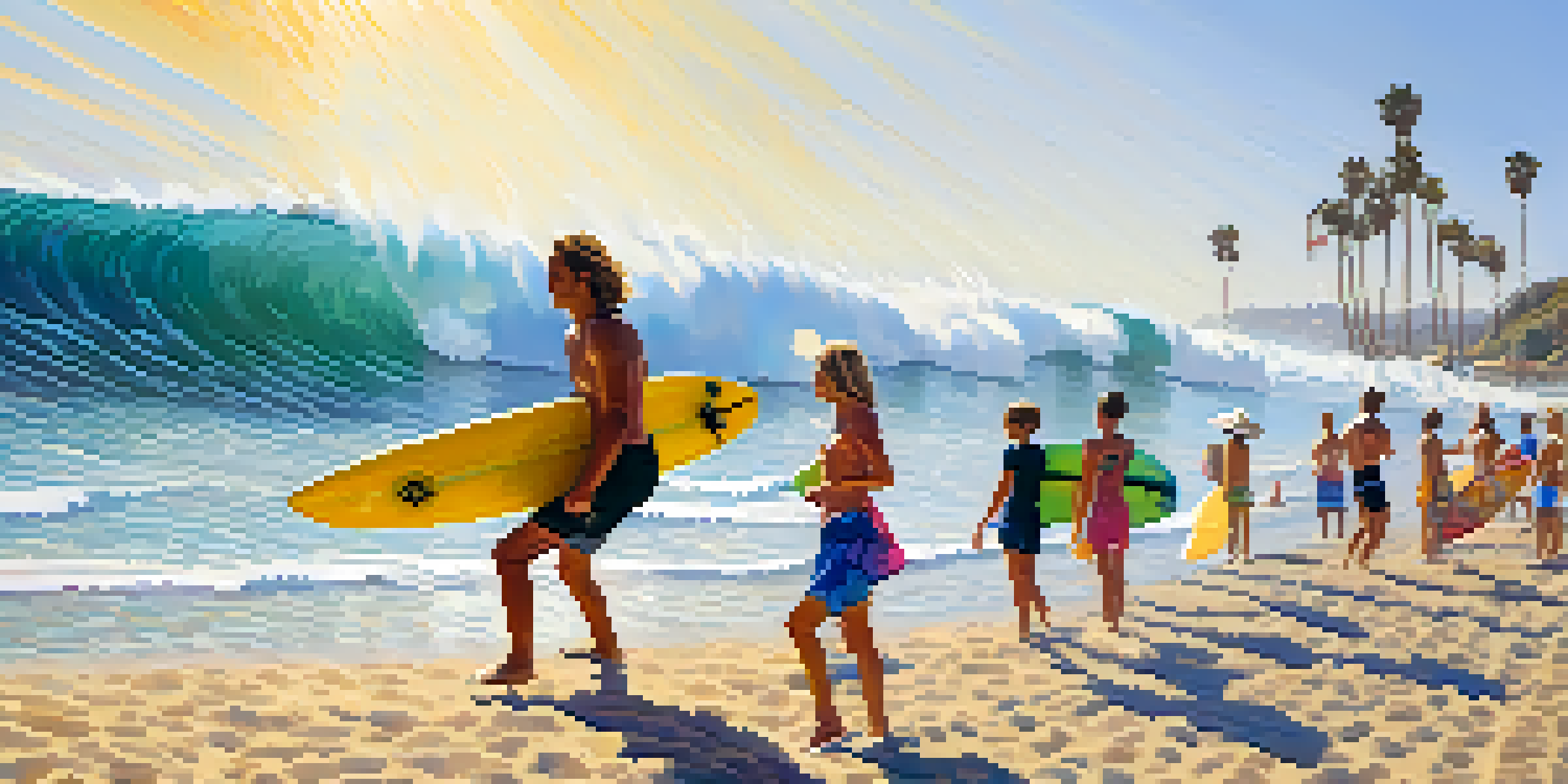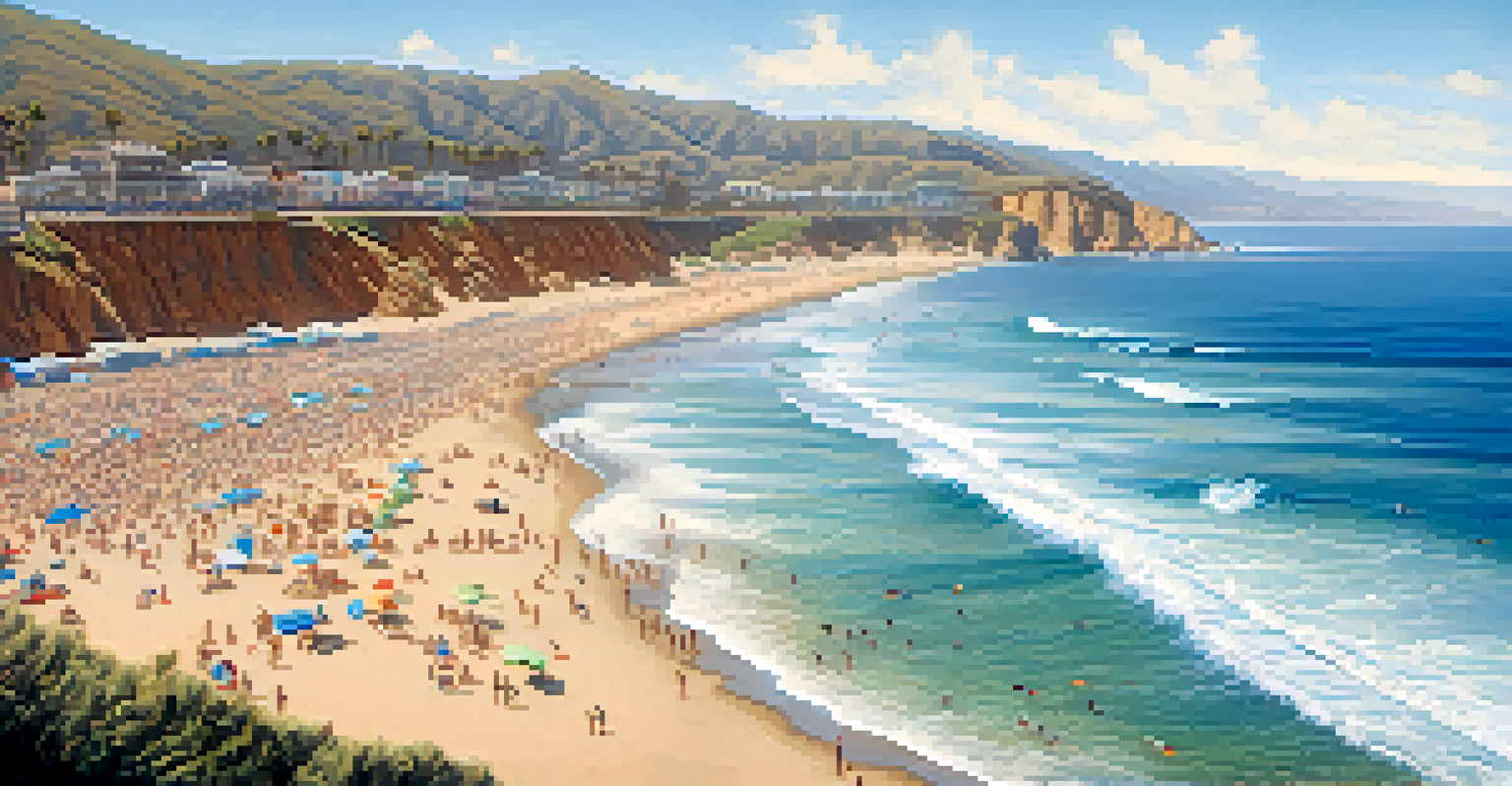The Evolution of Surf Competitions in Malibu Over the Years

The Birth of Surfing Competitions in Malibu
Surfing has been a beloved pastime in Malibu since the early 20th century, but it wasn't until the 1950s that organized competitions began to take shape. In those early days, surfers would gather informally to showcase their skills, with minimal rules and a laid-back atmosphere. The first official surf contest at Malibu, held in 1956, marked a significant milestone in the sport’s history.
Surfing is not just a sport; it's a way of life.
This event not only attracted local talent but also drew in surfers from across California, eager to compete in the pristine waves of Malibu. The excitement of the competition fostered a sense of community among surfers, which was vital to the culture of the sport. With the growing popularity of surfing, it became evident that competitions were here to stay.
The 1960s saw an explosion in surf culture, and Malibu was at the forefront. The beaches became a haven for both surfers and spectators, turning the once informal gatherings into a more structured competition format that included judges and scoring systems.
The Rise of Professional Surfing in the 1970s
As surfing gained recognition, the 1970s marked the transition into professional surfing. Events like the Malibu Invitational brought top-tier surfers to the forefront, showcasing their skills on a global stage. This era was characterized by increased media coverage, which helped elevate the status of surfing competitions significantly.

With professional surfers gaining sponsorships and media attention, competitions began to reflect the intensity and skill of the sport. The Malibu Invitational, in particular, became a prestigious event, drawing crowds and attention from beyond the local surf community. It was during this time that many surfers established themselves as icons in the sport, deeply influencing its trajectory.
Surfing Competitions Evolve Over Decades
From informal gatherings in the 1950s to structured competitions with global participation, Malibu's surf contests have significantly evolved.
The 1970s also saw the introduction of new technologies in surfboard design, which changed the dynamics of competition. Surfers began experimenting with different shapes and materials, enhancing their performance and pushing the boundaries of what was possible on the waves.
The Impact of the 1980s on Surf Competitions
The 1980s ushered in a new wave of surfers who brought fresh energy and style to Malibu competitions. This decade was marked by increased corporate sponsorships and a more commercialized approach to the sport. Events became larger productions, complete with elaborate setups and entertainment to engage spectators.
The best surfer out there is the one having the most fun.
The Malibu Pro, established during this time, became a hallmark event, attracting some of the best surfers in the world. It showcased not only the athleticism of the competitors but also the vibrant culture surrounding surfing. Surfers like Kelly Slater and Tom Curren began to dominate the scene, inspiring a new generation of athletes.
However, this commercialization also sparked conversations about the authenticity of surfing culture. Many traditional surfers expressed concerns that the sport was becoming too focused on profit and less on the love of riding waves. This debate highlighted the ongoing tension between the sport's roots and its evolution.
The 1990s: A Decade of Change and Innovation
As the surfing community entered the 1990s, innovations in board design and technology continued to shape competitions in Malibu. The introduction of shortboards revolutionized surfing styles, allowing for more aerial maneuvers and dynamic performances. Competitors began to push the limits of what could be achieved on the waves.
The Malibu Surfing Association played a crucial role in promoting local events and fostering talent, ensuring that the spirit of competition thrived. This decade also saw the rise of women in surfing, with female competitors gaining recognition and respect in the lineup. Events like the Women’s World Championship brought attention to their skills and contributions to the sport.
Youth Culture Shapes Surfing Today
The influence of young surfers is revitalizing the sport and promoting inclusivity through competitions like the Vans World Cup.
The 1990s were also characterized by a growing environmental consciousness within the surfing community. Surfers began advocating for ocean conservation and beach preservation, recognizing the impact of their sport on the environment. This shift in mindset added a new layer of purpose to competitions, emphasizing sustainability in surfing.
The New Millennium and the Rise of Global Competitions
As the new millennium dawned, surf competitions in Malibu began to take on a more global perspective. With the advent of the internet and social media, surfers could share their experiences and connect with fans worldwide. This globalization expanded the reach of Malibu competitions, attracting international talent and audiences.
Events like the World Surf League (WSL) Championship Tour included Malibu as a key stop, further cementing its status as a premier surfing destination. The competition format evolved to include more rigorous judging criteria and advanced technologies for scorekeeping, making the events more exciting and competitive than ever.
This era also saw a resurgence of interest in classic longboarding, with events celebrating traditional styles alongside high-performance shortboard events. This blend of old and new added depth to competitions, showcasing the diverse talents of surfers and appealing to a broader audience.
The Influence of Youth and the Future of Surf Competitions
Today, Malibu surf competitions are heavily influenced by the youth culture surrounding the sport. Young surfers are not only competing at high levels but are also becoming trendsetters, influencing styles, techniques, and even the types of boards used in competitions. This shift has breathed new life into the sport, making it more accessible and relatable to younger generations.
The inclusion of events like the Vans World Cup has made Malibu a beacon for aspiring surfers worldwide. With ample opportunities for youth to participate in competitions, the future of surfing looks bright. Local surf schools and programs are thriving, ensuring that the next generation is well-equipped to carry on the legacy.
Malibu: A Symbol of Surfing Excellence
Malibu remains a premier destination for surfing competitions, embodying a unique blend of tradition and innovation that inspires surfers worldwide.
Moreover, there is a growing emphasis on inclusivity within the sport. Initiatives to encourage participation from diverse backgrounds are gaining traction, further enriching the competitive landscape. As surfing continues to evolve, the spirit of camaraderie and competition in Malibu is likely to endure.
The Enduring Legacy of Malibu Surf Competitions
The legacy of surf competitions in Malibu is etched into the culture of surfing itself. The blend of tradition, innovation, and the spirit of competition has created a unique environment that continues to inspire surfers worldwide. As each decade has passed, the competitions have evolved, reflecting broader changes in society and the sport.
Today, Malibu remains a symbol of surfing excellence, attracting competitors and fans alike to its beautiful shores. The camaraderie among surfers, regardless of skill level, speaks to the heart of what makes surf competitions so special. They are not just contests; they are celebrations of a lifestyle rooted in passion and respect for the ocean.

Looking ahead, Malibu will undoubtedly continue to play a pivotal role in shaping the future of surfing competitions. As new waves break and fresh talent emerges, the spirit of competition will remain a vital part of the surfing community, ensuring that the legacy of Malibu endures for generations to come.